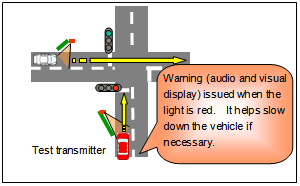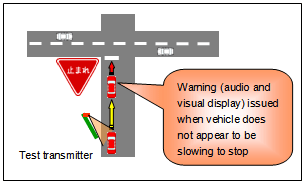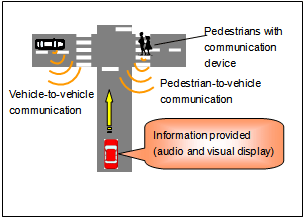Nov. 26, 2007
Toyota Demonstrates ITS-based Safety Technology
―Latest Systems Allow Vehicles to Communicate with Surroundings―
Tokyo ― TOYOTA MOTOR CORPORATION (TMC) demonstrated today its latest advances in vehicle-infrastructure cooperative systems*, which use Intelligent Transport Systems (ITS) technologies to enable communication between cars and elements of their surroundings in an effort to reduce collisions.
The cooperative systems, presented at a media event at TMC's Higashi Fuji Technical Center, make road-to-vehicle, vehicle-to-vehicle and pedestrian-to-vehicle information exchange possible, resulting in audio and visual warnings to drivers when a collision is probable. After further development, these systems―which can even reduce vehicle speed, if needed―are expected to reduce the number of traffic accidents that are difficult to prevent with conventional safety devices.
TMC's development of ITS vehicle-infrastructure cooperative systems represents―along with the development and application of autonomous onboard safety devices―part of its efforts to develop safe vehicles under its Integrated Safety Management Concept, which was announced in August 2006 outlining that TMC aims to provide optimal driving support through a combination of integrated onboard technologies and infrastructure-respondent systems.
As a part of its efforts to realize sustainable mobility, TMC intends to strengthen its traffic safety initiatives in the future through: 1) the development of even safer vehicles and technologies, 2) participation in the creation of a safe traffic environment and 3) activities designed to educate people in traffic safety, thereby contributing to the complete elimination of traffic accidents and traffic casualties, which can be viewed as the ultimate hope of a society that values mobility.
*ITS-based cooperative systems receive information from communications infrastructure installed along the roadside and from other vehicles concerning traffic signs as well as objects that the driver cannot directly see, among other things. These systems notify the driver of beyond-view traffic signs and/or objects to support safe driving and help prevent accidents.
The cooperative systems, presented at a media event at TMC's Higashi Fuji Technical Center, make road-to-vehicle, vehicle-to-vehicle and pedestrian-to-vehicle information exchange possible, resulting in audio and visual warnings to drivers when a collision is probable. After further development, these systems―which can even reduce vehicle speed, if needed―are expected to reduce the number of traffic accidents that are difficult to prevent with conventional safety devices.
TMC's development of ITS vehicle-infrastructure cooperative systems represents―along with the development and application of autonomous onboard safety devices―part of its efforts to develop safe vehicles under its Integrated Safety Management Concept, which was announced in August 2006 outlining that TMC aims to provide optimal driving support through a combination of integrated onboard technologies and infrastructure-respondent systems.
As a part of its efforts to realize sustainable mobility, TMC intends to strengthen its traffic safety initiatives in the future through: 1) the development of even safer vehicles and technologies, 2) participation in the creation of a safe traffic environment and 3) activities designed to educate people in traffic safety, thereby contributing to the complete elimination of traffic accidents and traffic casualties, which can be viewed as the ultimate hope of a society that values mobility.
*ITS-based cooperative systems receive information from communications infrastructure installed along the roadside and from other vehicles concerning traffic signs as well as objects that the driver cannot directly see, among other things. These systems notify the driver of beyond-view traffic signs and/or objects to support safe driving and help prevent accidents.
Outline of vehicle-infrastructure cooperative systems demonstrated by TMC
Figure 1


|
Road-to-vehicle system for preventing drivers from running red lights A roadside transmitter sends traffic light information to the vehicle. When there is a possibility that the vehicle will run a red light, the driver receives audio and visual-display warnings. When necessary, the system helps slow the vehicle to a safe speed. (See Figure 1.) |
Outline of vehicle-infrastructure cooperative systems demonstrated by TMC
Figure 2


|
Road-to-vehicle system for preventing drivers from missing stop signs A roadside transmitter sends stop sign information to the vehicle. When the driver overlooks a stop sign and the vehicle fails to stop, the driver receives audio and visual-display warnings. (See Figure 2.) |
Outline of vehicle-infrastructure cooperative systems demonstrated by TMC
Figure 3


|
Vehicle-to-vehicle system for detecting approaching vehicles Mutual information exchange is conducted between vehicles. The driver receives audio and visual-display information regarding an approaching vehicle and its position. (See Figure 3.) Pedestrian-to-vehicle system for detecting pedestrians Pedestrian-carried devices emit radio signals that are detected by the vehicle. The driver receives audio and visual-display information regarding pedestrians. (See Figure 3.) |
Also demonstrated by TMC was a road-to-vehicle system for detecting approaching vehicles.







